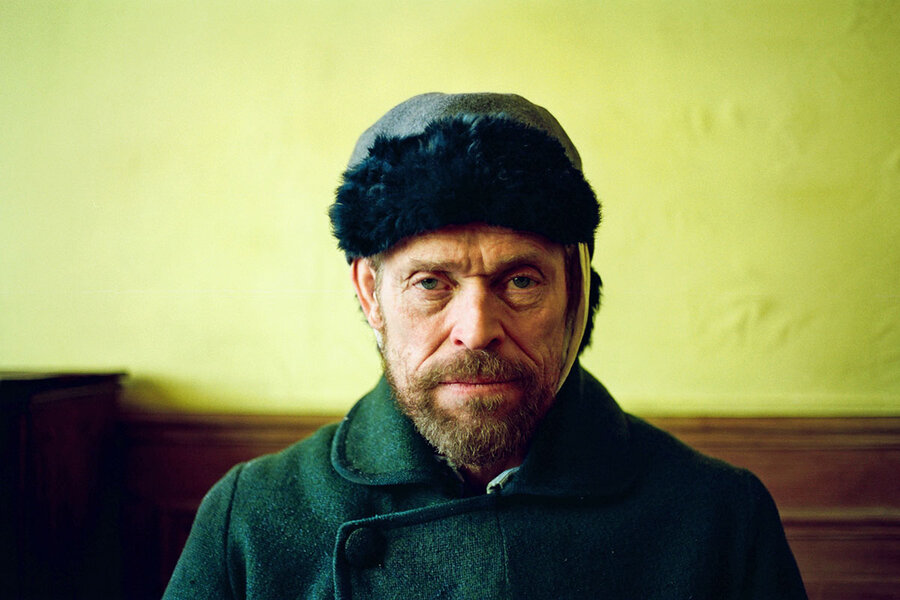‘At Eternity’s Gate’ features career-best Willem Dafoe
Loading...
“I am my paintings,” says Vincent van Gogh, played by Willem Dafoe in a career-best performance, in Julian Schnabel’s “At Eternity’s Gate,” which follows the artist through his last tumultuous and astonishingly prolific years in the late 1880s in the south of France. Watching this explosively lyrical film, you can believe it. I must admit that my first reaction to seeing yet another movie about Van Gogh was not welcoming, especially since several of these, including “Lust for Life” and Robert Altman’s “Vincent & Theo,” are so good. Wasn’t it just last year that we had the entirely hand-drawn animated “Loving Vincent”? What’s left to do: “Vincent: The Musical”?
Schnabel is, of course, a celebrated artist as well as a powerful, if powerfully uneven, filmmaker, and what he captures here is what it must have been like to be Van Gogh. It’s an artist’s imagining of what another artist might have felt. He never does break away from the romantic, madness-of-genius cliché that has dogged so many movies and commentaries about Van Gogh. Instead, he embraces it because he believes it authenticates the turmoil that goes into creating great art. Of course, turmoil can also create bad art, but such is Schnabel’s ardor that I bought into the banality even though I think Van Gogh was a great artist despite rather than because of his mental anguish.
Much of Van Gogh’s spoken words in the movie are drawn from his letters, and their passion matches up with the paintings. In the film, he talks about how he needs to be in a fever in order to paint, and there are moments, such as Vincent walking into the bright golden Saint-Rémy at dawn with his easel and brushes, when I could feel his almost pantheistic communion with nature. “I feel God is nature and nature is beauty,” he says, and this intensity is transferred directly onto the canvas.
Vincent lays the paint on very thick, so much so that Paul Gauguin (Oscar Isaac), with whom he had a famously fraught friendship, remarks that his paintings are more like sculpture. He asks Vincent, “Why do you always paint from nature? Why don’t you just paint what’s in your mind?” What he doesn’t recognize is that, for Van Gogh, what is in his mind is what is out there in nature, waiting to be seized. He has to paint furiously because nature – sanity itself – is evanescent.
I don’t mean to suggest that the Van Gogh of this movie is some sort of trippy flower child. Dafoe’s portrayal is a great deal more complicated than that. The greatness of his performance is that we can see, if perhaps Schnabel can’t entirely, that Vincent is a dreamer, yes, but he is also, in his more lucid moments, a hard-edged realist riven by his demons. “I have to paint...,” he tells a sympathetic priest (Mads Mikkelsen). “I can’t do anything else and believe me, I’ve tried.” Vincent is not without his soulmates, foremost his loving brother, Theo (Rupert Friend), an art dealer who supported him because his paintings never sold. But what comes through most formidably in Dafoe’s acting is Vincent’s encroaching sense of isolation – his great and shuddering aloneness. He finds joy in sorrow because he has no choice.
At its best, the film, written by Schnabel, Jean-Claude Carrière, and Louise Kugelberg, allows us the heady experience of seeing as Van Gogh sees. He strides into the fields and forests and we try to imagine how he will capture it on canvas. Sometimes Schnabel overdoes the jarring, dissociative visual effects. It’s the same mistake movie directors often make when filming Shakespeare: You shouldn’t try to compete with the master. But the effort is understandable and far preferable to the conventional biopic approach.
I have a bit less sympathy for the ways in which the filmmakers shoehorn conjecture and flat-out mythmaking into the narrative. Vincent, it seems, cut off part of his ear as a kind of peace offering to Gauguin, he was shot to death by unruly schoolboys, and so on. Van Gogh’s life is already plenty mythologized without this dubious extra coating.
But the film comes to a great and sorrowing finish when we hear Vincent’s words, “I thought an artist has to teach a way to look at the rest of the world. Not anymore. Now I just think of my relationship with eternity.” One of the great achievements of this movie is that, in the end, Van Gogh’s words enter into our soul with the same force as the paintings. Grade: A- (Rated PG-13 for some thematic content.)







